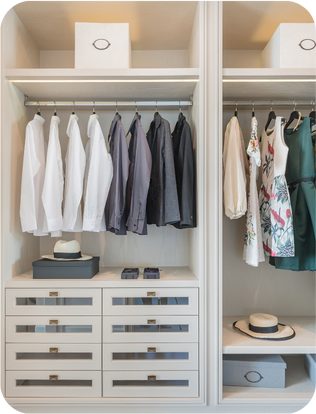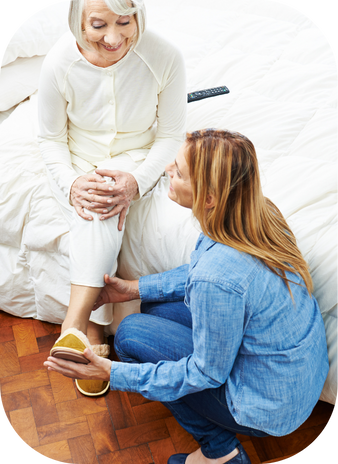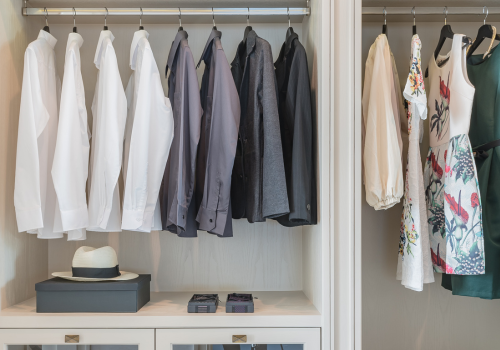Home > Living Well with Dementia > Getting dressed

Dressing involves multiple skills like planning, sequencing, and balance. As such, it can be challenging for individuals with dementia to dress themselves, depending on the stage of their condition. Caregivers may need to help individuals with dementia choose and wear clothes that are climate-appropriate, size-appropriate, and hygienic.
Here are some ways caregivers can help facilitate independent dressing for individuals living with dementia:[1], [2]

01: Help keep an organized closet.
- Rearrange their closet each season and store away clothing that is unsuitable for the current weather.
- Categorize clothing by type and label drawers with words and pictures.
- Prevent anxiety by storing their favorite clothes in easy-to-find places.
02: Consider using adaptive clothing design.
- Where possible, use Velcro instead of buttons or zippers.
- Choose non-slip shoes to prevent falls.
- Consider extra wide slip-on shoe options.
- Consider clothing with an open-back design.
- Avoid clothing that needs to be pulled over the head.
03: Create a safe and comfortable dressing environment.
- Help them dress in a comfortable and safe area, and avoid dressing in areas like wet bathrooms.
- If it is safe for individuals with dementia to dress independently, caregivers should step out of the room after setting up for dressing to provide privacy.
- In situations where individuals need to change in public, use a cape to cover their body.

04: Provide assistance as needed during the dressing process.
- Lay out clothing according to the dressing sequence.
- Offer guidance in the initial steps and encourage individuals with dementia to dress independently.
- Provide simple and direct instructions when needed.
05: Be respectful.
- Respect the individual’s choice of clothing, style, and culture.
- Allow enough time for individuals to dress – do not rush them.
- Avoid blaming them, even if they make mistakes or struggle with dressing.

Getting Dressed
Dressing involves multiple skills like planning, sequencing, and balance. As such, it can be challenging for individuals with dementia to dress themselves, depending on the stage of their condition. Caregivers may need to help individuals with dementia choose and wear clothes that are climate-appropriate, size-appropriate, and hygienic.
Here are some ways caregivers can help facilitate independent dressing for individuals living with dementia:[1], [2
01: Help keep an organized closet.
- Rearrange their closet each season and store away clothing that is unsuitable for the current weather.
- Categorize clothing by type and label drawers with words and pictures.
- Prevent anxiety by storing their favorite clothes in easy-to-find places.
02: Consider using adaptive clothing design.
- Where possible, use Velcro instead of buttons or zippers.
- Choose non-slip shoes to prevent falls.
- Consider extra wide slip-on shoe options.
- Consider clothing with an open-back design.
- Avoid clothing that needs to be pulled over the head.
03: Create a safe and comfortable dressing environment.
- Help them dress in a comfortable and safe area, and avoid dressing in areas like wet bathrooms.
- If it is safe for individuals with dementia to dress independently, caregivers should step out of the room after setting up for dressing to provide privacy.
- In situations where individuals need to change in public, use a cape to cover their body.
04: Provide assistance as needed during the dressing process.
- Lay out clothing according to the dressing sequence.
- Offer guidance in the initial steps and encourage individuals with dementia to dress independently.
- Provide simple and direct instructions when needed.
05: Be respectful.
- Respect the individual’s choice of clothing, style, and culture.
- Allow enough time for individuals to dress – do not rush them.
- Avoid blaming them, even if they make mistakes or struggle with dressing.
Useful Resources
- Alzheimer Society of Canada: Dressing
- Alzheimer Society of UK: How to support a person with dementia to get dressed or change clothes
- Hong Kong Jockey Club Centre for Positive Ageing: EP5 – Getting Dressed – Caregiver Tips for Dementia – Caring skills for Everyday Life (Cantonese video with English and Chinese subtitles)
References
[1] Nash, M., & Foidel, S. (2019). Strength-Based Person-Centered Dementia Care: Activities of Daily Livindfg. In Neurocognitive Behavioral Disorders (pp. 157–198). Springer International Publishing AG. https://doi.org/10.1007/978-3-030-11268-4_8
[2] Prizer, L. P., & Zimmerman, S. (2018). Progressive Support for Activities of Daily Living for Persons Living With Dementia. The Gerontologist, 58(suppl_1), S74–S87. https://doi.org/10.1093/geront/gnx103
